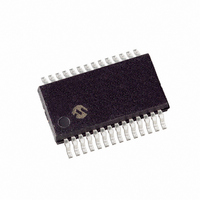PIC18F26J50-I/SS Microchip Technology, PIC18F26J50-I/SS Datasheet - Page 34

PIC18F26J50-I/SS
Manufacturer Part Number
PIC18F26J50-I/SS
Description
IC PIC MCU FLASH 64K 2V 28-SSOP
Manufacturer
Microchip Technology
Series
PIC® XLP™ 18Fr
Datasheets
1.PIC18LF24J10-ISS.pdf
(32 pages)
2.PIC18LF24J50-ISS.pdf
(554 pages)
3.PIC18LF24J50-ISS.pdf
(12 pages)
Specifications of PIC18F26J50-I/SS
Core Size
8-Bit
Program Memory Size
64KB (32K x 16)
Core Processor
PIC
Speed
48MHz
Connectivity
I²C, SPI, UART/USART, USB
Peripherals
Brown-out Detect/Reset, DMA, POR, PWM, WDT
Number Of I /o
16
Program Memory Type
FLASH
Ram Size
3.8K x 8
Voltage - Supply (vcc/vdd)
2.15 V ~ 3.6 V
Data Converters
A/D 10x10b
Oscillator Type
Internal
Operating Temperature
-40°C ~ 85°C
Package / Case
28-SSOP
Controller Family/series
PIC18
No. Of I/o's
16
Ram Memory Size
3.6875KB
Cpu Speed
48MHz
No. Of Timers
2
Interface
EUSART, I2C, SPI, USB
Processor Series
PIC18F
Core
PIC
Data Bus Width
8 bit
Data Ram Size
3776 B
Interface Type
EUSART, I2C, SPI
Maximum Clock Frequency
48 MHz
Number Of Timers
5
Maximum Operating Temperature
+ 85 C
Mounting Style
SMD/SMT
3rd Party Development Tools
52715-96, 52716-328, 52717-734, 52712-325, EWPIC18
Development Tools By Supplier
PG164130, DV164035, DV244005, DV164005, PG164120, DM183032, DV164136, MA180024, DM183022
Minimum Operating Temperature
- 40 C
On-chip Adc
10 bit, 10 Channel
Package
28SSOP
Device Core
PIC
Family Name
PIC18
Maximum Speed
48 MHz
Operating Supply Voltage
2.5|3.3 V
Lead Free Status / RoHS Status
Lead free / RoHS Compliant
For Use With
AC164322 - MODULE SOCKET MPLAB PM3 28/44QFN
Eeprom Size
-
Lead Free Status / Rohs Status
Details
- Current page: 34 of 554
- Download datasheet (9Mb)
PIC18F46J50 FAMILY
REGISTER 2-1:
2.3
When the PIC18F46J50 Family devices are used for
USB connectivity, a 6 MHz or 48 MHz clock must be
provided to the USB module for operation in either
Low-Speed or Full-Speed modes, respectively. This
may require some forethought in selecting an oscillator
frequency and programming the device.
The full range of possible oscillator configurations
compatible with USB operation is shown in Table 2-5.
2.3.1
The USB clock for Low-Speed mode is derived from the
primary oscillator or from the 96 MHz PLL. In order to
operate the USB module in Low-Speed mode, a 6 MHz
clock must be provided to the USB module. Due to the
way the clock dividers have been implemented in the
DS39931C-page 34
bit 7
Legend:
R = Readable bit
-n = Value at POR
bit 7
bit 6
bit 5-0
INTSRC
R/W-0
Oscillator Settings for USB
LOW-SPEED OPERATION
INTSRC: Internal Oscillator Low-Frequency Source Select bit
1 = 31.25 kHz device clock derived from 8 MHz INTOSC source (divide-by-256 enabled)
0 = 31 kHz device clock derived directly from INTRC internal oscillator
PLLEN: Frequency Multiplier Enable bit
1 = 96 MHz PLL is enabled
0 = 96 MHz PLL is disabled
TUN<5:0>: Frequency Tuning bits
011111 = Maximum frequency
011110
•
•
•
000001
000000 = Center frequency; oscillator module is running at the calibrated frequency
111111
•
•
•
100000 = Minimum frequency
PLLEN
R/W-0
OSCTUNE: OSCILLATOR TUNING REGISTER (ACCESS F9Bh)
W = Writable bit
‘1’ = Bit is set
R/W-0
TUN5
R/W-0
TUN4
U = Unimplemented bit, read as ‘0’
‘0’ = Bit is cleared
R/W-0
TUN3
PIC18F46J50 Family, the microcontroller core must
run at 24 MHz in order for the USB module to get the
6 MHz clock needed for low-speed USB operation.
Several clocking schemes could be used to meet these
two required conditions. See Table 2-4 and Table 2-5
for possible combinations which can be used for
low-speed USB operation.
TABLE 2-4:
Clock
Input
48
24
Clock
CPU
24
24
R/W-0
TUN2
CLOCK FOR LOW-SPEED USB
CPDIV<1:0>
© 2009 Microchip Technology Inc.
x = Bit is unknown
‘10’
‘11’
R/W-0
TUN1
48/8 = 6 MHz
24/4 = 6 MHz
USB Clock
R/W-0
TUN0
bit 0
Related parts for PIC18F26J50-I/SS
Image
Part Number
Description
Manufacturer
Datasheet
Request
R

Part Number:
Description:
Manufacturer:
Microchip Technology Inc.
Datasheet:

Part Number:
Description:
Manufacturer:
Microchip Technology Inc.
Datasheet:

Part Number:
Description:
Manufacturer:
Microchip Technology Inc.
Datasheet:

Part Number:
Description:
Manufacturer:
Microchip Technology Inc.
Datasheet:

Part Number:
Description:
Manufacturer:
Microchip Technology Inc.
Datasheet:

Part Number:
Description:
Manufacturer:
Microchip Technology Inc.
Datasheet:

Part Number:
Description:
Manufacturer:
Microchip Technology Inc.
Datasheet:

Part Number:
Description:
Manufacturer:
Microchip Technology Inc.
Datasheet:










